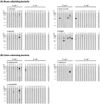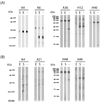Immunoglobulin E antibody reactivity to bacterial antigens in atopic dermatitis patients
- PMID: 21155910
- PMCID: PMC3057935
- DOI: 10.1111/j.1365-2222.2010.03655.x
Immunoglobulin E antibody reactivity to bacterial antigens in atopic dermatitis patients
Abstract
Background: Atopic dermatitis (AD) is a chronic inflammatory skin disease affecting up to 20% children and 9% adults world-wide. AD patients are often sensitized against a broad variety of allergens and more than 90% of them suffer from skin superinfections with Staphylococcus aureus.
Objective: In this study, we searched for the presence of specific IgE antibodies against S. aureus and Escherichia coli antigens in AD patients.
Methods: Sera from AD patients (n=79), patients suffering only from allergic rhinoconjunctivitis (n=41) or allergic asthma (n=37) were tested for IgE reactivity to nitrocellulose-blotted S. aureus, E. coli and gut bacterial antigens. IgE-reactive bacterial antigens were affinity purified and identified by mass spectrometry.
Results: More than 30% of AD patients but not patients suffering only from allergic rhinoconjunctivitis and asthma or non-allergic persons exhibited IgE binding to several protein antigens among them DNA-binding and ribosomal proteins and flagellin. Patients with severe skin manifestations showed more frequently IgE reactivity to S. aureus compared with AD patients with mild symptoms. Positive immediate and late skin test reactions could be induced in sensitized AD patients with S. aureus extract.
Conclusion and clinical relevance: Specific IgE reactivities against a variety of bacterial antigens were observed in a subgroup comprising a third of AD patients and may contribute to allergic inflammation.
© 2010 Blackwell Publishing Ltd.
Conflict of interest statement
The authors state no conflict of interest.
Figures






References
-
- Williams H, Robertson C, Stewart A, Ait-Khaled N, Anabwani G, Anderson R, Asher I, Beasley R, Bjorksten B, Burr M, Clayton T, Crane J, Ellwood P, Keil U, Lai C, Mallol J, Martinez F, Mitchell E, Montefort S, Pearce N, Shah J, Sibbald B, Strachan D, von Mutius E, Weiland SK. Worldwide variations in the prevalence of symptoms of atopic eczema in the International Study of Asthma and Allergies in Childhood. J Allergy Clin Immunol. 1999;103:125–138. - PubMed
-
- Herd RM, Tidman MJ, Prescott RJ, Hunter JA. Prevalence of atopic eczema in the community: the Lothian Atopic Dermatitis study. Br J Dermatol. 1996;135:18–19. - PubMed
-
- Ingordo V, D'Andria G, D'Andria C. Adult-onset atopic dermatitis in a patch test population. Dermatology. 2003;206:197–203. - PubMed
-
- Beasley R, Keil U, von Mutius E, Pearce N. Worldwide variation in prevalence of symptoms of asthma, allergic rhinoconjunctivitis, and atopic eczema: ISAAC. The International Study of Asthma and Allergies in Childhood (ISAAC) Steering Committee. Lancet. 1998;351:1225–1232. - PubMed
Publication types
MeSH terms
Substances
Grants and funding
LinkOut - more resources
Full Text Sources
Other Literature Sources

